Bloom's Taxonomy of Learning Domains
The Three Domains of Learning
The committee identified three domains of educational activities or learning (Bloom, et al. 1956):-
Cognitive: mental skills (knowledge)
-
Affective: growth in feelings or emotional areas (attitude or self)
-
Psychomotor: manual or physical skills (skills)
While the committee produced an elaborate compilation for the cognitive and affective domains, they omitted the psychomotor domain. Their explanation for this oversight was that they have little experience in teaching manual skills within the college level. However, there have been at least three psychomotor models created by other researchers.
Their compilation divides the three domains into subdivisions, starting from the simplest cognitive process or behavior to the most complex. The divisions outlined are not absolutes and there are other systems or hierarchies that have been devised, such as the Structure of Observed Learning Outcome (SOLO). However, Bloom's taxonomy is easily understood and is probably the most widely applied one in use today.
Cognitive Domain
 The cognitive domain involves knowledge and the development of
intellectual skills (Bloom, 1956). This includes the recall or
recognition of specific facts, procedural patterns, and concepts that
serve in the development of intellectual abilities and skills. There are
six major categories of cognitive an processes, starting from the
simplest to the most complex (see the table below for an in-depth coverage of each category):
The cognitive domain involves knowledge and the development of
intellectual skills (Bloom, 1956). This includes the recall or
recognition of specific facts, procedural patterns, and concepts that
serve in the development of intellectual abilities and skills. There are
six major categories of cognitive an processes, starting from the
simplest to the most complex (see the table below for an in-depth coverage of each category):- Knowledge
- Comprehension
- Application
- Analysis
- Synthesis
- Evaluation
Bloom's Revised Taxonomy
Lorin Anderson, a former student of Bloom, and David Krathwohl revisited the cognitive domain in the mid-nineties and made some changes, with perhaps the three most prominent ones being (Anderson, Krathwohl, Airasian, Cruikshank, Mayer, Pintrich, Raths, Wittrock, 2000):- changing the names in the six categories from noun to verb forms
- rearranging them as shown in the chart below
- creating a processes and levels of knowledge matrix
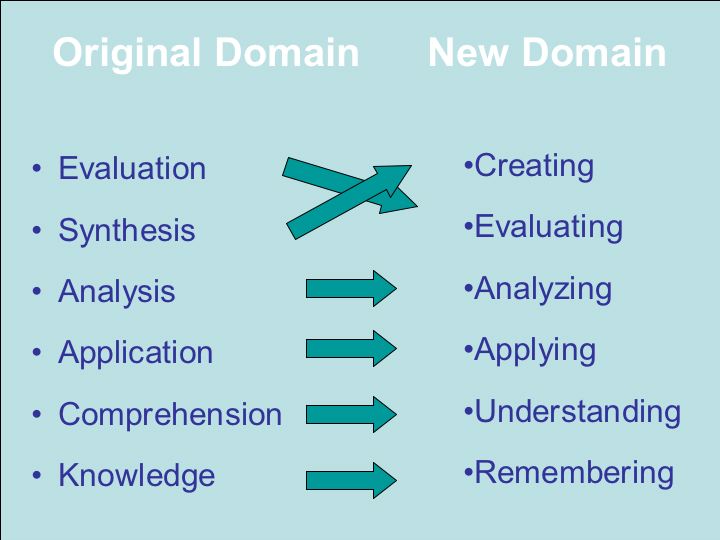

This new taxonomy reflects a more active form of thinking and is perhaps more accurate. The new version of Bloom's Taxonomy, with examples and keywords is shown below, while the old version may be found here
Table of the Revised Cognitive Domain
Category |
Examples, key words (verbs), and technologies for learning (activities) |
| Remembering: Recall or retrieve previous learned information. | Examples: Recite a policy. Quote prices from memory to a customer. Recite the
safety rules. Key Words: defines, describes, identifies, knows, labels, lists, matches, names, outlines, recalls, recognizes, reproduces, selects, states Technologies: book marking, flash cards, rote learning based on repetition, reading |
| Understanding: Comprehending the meaning, translation, interpolation, and interpretation of instructions and problems. State a problem in one's own words. | Examples: Rewrite the principles of test writing. Explain in one's own
words the steps for performing a complex task. Translate an equation into a
computer spreadsheet. Key Words: comprehends, converts, defends, distinguishes, estimates, explains, extends, generalizes, gives an example, infers, interprets, paraphrases, predicts, rewrites, summarizes, translates Technologies: create an analogy, participating in cooperative learning, taking notes, storytelling, Internet search |
| Applying: Use a concept in a new situation or unprompted use of an abstraction. Applies what was learned in the classroom into novel situations in the work place. | Examples: Use a manual to calculate an employee's vacation time. Apply laws
of statistics to evaluate the reliability of a written test. Key Words: applies, changes, computes, constructs, demonstrates, discovers, manipulates, modifies, operates, predicts, prepares, produces, relates, shows, solves, uses Technologies: collaborative learning, create a process, blog, practice |
| Analyzing: Separates material or concepts into component parts so that its organizational structure may be understood. Distinguishes between facts and inferences. | Examples: Troubleshoot a piece of equipment by using logical deduction.
Recognize logical fallacies in reasoning. Gathers information from a
department and selects the required tasks for training. Key Words: analyzes, breaks down, compares, contrasts, diagrams, deconstructs, differentiates, discriminates, distinguishes, identifies, illustrates, infers, outlines, relates, selects, separates Technologies: Fishbowls, debating, questioning what happened, run a test |
| Evaluating: Make judgments about the value of ideas or materials. | Examples: Select the most effective solution. Hire the most qualified
candidate. Explain and justify a new budget. Key Words: appraises, compares, concludes, contrasts, criticizes, critiques, defends, describes, discriminates, evaluates, explains, interprets, justifies, relates, summarizes, supports Technologies: survey, blogging |
| Creating: Builds a structure or pattern from diverse elements. Put parts together to form a whole, with emphasis on creating a new meaning or structure. | Examples: Write a company operations or process manual. Design a machine to
perform a specific task. Integrates training from several sources to solve a
problem. Revises and process to improve the outcome. Key Words: categorizes, combines, compiles, composes, creates, devises, designs, explains, generates, modifies, organizes, plans, rearranges, reconstructs, relates, reorganizes, revises, rewrites, summarizes, tells, writes Technologies: Create a new model, write an essay, network with others |
Cognitive Processes and Levels of Knowledge Matrix
Bloom's Revised Taxonomy not only improved the usability of it by using action words, but added a cognitive and knowledge matrix.While Bloom's original cognitive taxonomy did mention three levels of knowledge or products that could be processed, they were not discussed very much and remained one-dimensional:
- Factual - The basic elements students must know to be acquainted with a discipline or solve problems.
- Conceptual – The interrelationships among the basic elements within a larger structure that enable them to function together.
- Procedural - How to do something, methods of inquiry, and criteria for using skills, algorithms, techniques, and methods.
- Metacognitive – Knowledge of cognition in general, as well as awareness and knowledge of one’s own cognition.
The Cognitive Dimension
| The Knowledge Dimension | Remember | Under-stand | Apply | Analyze | Evaluate | Create |
|---|---|---|---|---|---|---|
| Factual | ||||||
| Conceptual | ||||||
| Procedural | ||||||
| Metacognitive |
- Facts - Specific and unique data or instance.
- Concepts - A class of items, words, or ideas that are known by a common name, includes multiple specific examples, shares common features. There are two types of concepts: concrete and abstract.
- Processes - A flow of events or activities that describe how things work rather than how to do things. There are normally two types: business processes that describe work flows and technical processes that describe how things work in equipment or nature. They may be thought of as the big picture, of how something works.
- Procedures - A series of step-by-step actions and decisions that result in the achievement of a task. There are two types of actions: linear and branched.
- Principles - Guidelines, rules, and parameters that govern. It includes not only what should be done, but also what should not be done. Principles allow one to make predictions and draw implications. Given an effect, one can infer the cause of a phenomena. Principles are the basic building blocks of causal models or theoretical models (theories).
The Cognitive Dimension
| The Knowledge Dimension | Remember | Under-stand | Apply | Analyze | Evaluate | Create |
|---|---|---|---|---|---|---|
| Facts | ||||||
| Concepts | ||||||
| Processes | ||||||
| Procedures | ||||||
| Principles | ||||||
| Metacognitive |
| The Knowledge Dimension | Remember | Under-stand | Apply | Analyze | Evaluate | Create |
|---|---|---|---|---|---|---|
| Facts | list | para-phrase | classify | outline | rank | categorize |
| Concepts | recall | explains | show | contrast | criticize | modify |
| Processes | outline | estimate | produce | diagram | defend | design |
| Procedures | reproduce | give an example | relate | identify | critique | plan |
| Principles | state | converts | solve | different-iates | conclude | revise |
| Meta-cognitive | proper use | interpret | discover | infer | predict | actualize |
Bloom's Taxonomy: The Affective Domain
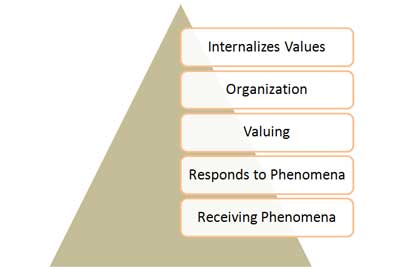
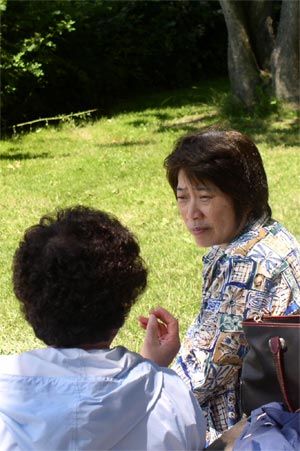 The affective domain is one of three domains in Bloom's Taxonomy, with the other two being the cognitive and psychomotor (Bloom, et al., 1956). For an overview of the three domains, see the introduction.
The affective domain is one of three domains in Bloom's Taxonomy, with the other two being the cognitive and psychomotor (Bloom, et al., 1956). For an overview of the three domains, see the introduction.The affective domain (Krathwohl, Bloom, Masia, 1973) includes the manner in which we deal with things emotionally, such as feelings, values, appreciation, enthusiasms, motivations, and attitudes. The five major categories are listed from the simplest behavior to the most complex:
Category |
Example and Key Words (verbs) |
| Receiving Phenomena: Awareness, willingness to hear, selected attention. | Examples: Listen to others with respect. Listen for and remember the name of newly introduced people. Key Words: acknowledge, asks, attentive, courteous, dutiful, follows, gives, listens, understands |
| Responds to Phenomena: Active participation on the part of the learners. Attend and react to a particular phenomenon. Learning outcomes may emphasize compliance in responding, willingness to respond, or satisfaction in responding (motivation). | Examples: Participates in class discussions. Gives a
presentation. Questions new ideals, concepts, models, etc. in order to
fully understand them. Know the safety rules and practice them. Key Words: answers, assists, aids, complies, conforms, discusses, greets, helps, labels, performs, presents, tells |
| Valuing: The worth or value a person attaches to a particular object, phenomenon, or behavior. This ranges from simple acceptance to the more complex state of commitment. Valuing is based on the internalization of a set of specified values, while clues to these values are expressed in the learner's overt behavior and are often identifiable. | Examples: Demonstrates belief in the democratic
process. Is sensitive towards individual and cultural differences (value
diversity). Shows the ability to solve problems. Proposes a plan to
social improvement and follows through with commitment. Informs
management on matters that one feels strongly about. Key Words: appreciates, cherish, treasure, demonstrates, initiates, invites, joins, justifies, proposes, respect, shares |
| Organization: Organizes values into priorities by contrasting different values, resolving conflicts between them, and creating an unique value system. The emphasis is on comparing, relating, and synthesizing values. | Examples: Recognizes the need for balance between
freedom and responsible behavior. Explains the role of systematic
planning in solving problems. Accepts professional ethical standards.
Creates a life plan in harmony with abilities, interests, and beliefs.
Prioritizes time effectively to meet the needs of the organization,
family, and self. Key Words: compares, relates, synthesizes |
| Internalizes Values (characterization): Has a value system that controls their behavior. The behavior is pervasive, consistent, predictable, and most important characteristic of the learner. Instructional objectives are concerned with the student's general patterns of adjustment (personal, social, emotional). | Examples: Shows self-reliance when working
independently. Cooperates in group activities (displays teamwork). Uses
an objective approach in problem solving.
Displays a professional commitment to ethical practice on a daily
basis. Revises judgments and changes behavior in light of new evidence.
Values people for what they are, not how they look. Key Words: acts, discriminates, displays, influences, modifies, performs, qualifies, questions, revises, serves, solves, verifies |
Bloom's Taxonomy: The Psychomotor Domain
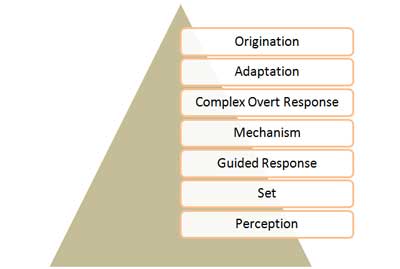
 The psychomotor domain (Simpson, 1972) includes physical movement,
coordination, and use of the motor-skill areas. Development of these
skills requires practice and is measured in terms of speed, precision,
distance, procedures, or techniques in execution. Thus, psychomotor
skills rage from manual tasks, such as digging a ditch or washing a car,
to more complex tasks, such as operating a complex piece of machinery
or dancing.
The psychomotor domain (Simpson, 1972) includes physical movement,
coordination, and use of the motor-skill areas. Development of these
skills requires practice and is measured in terms of speed, precision,
distance, procedures, or techniques in execution. Thus, psychomotor
skills rage from manual tasks, such as digging a ditch or washing a car,
to more complex tasks, such as operating a complex piece of machinery
or dancing.The seven major categories are listed from the simplest behavior to the most complex:
Category |
Example and Key Words (verbs) |
| Perception (awareness): The ability to use sensory cues to guide motor activity. This ranges from sensory stimulation, through cue selection, to translation. | Examples: Detects non-verbal communication cues.
Estimate where a ball will land after it is thrown and then moving to
the correct location to catch the ball. Adjusts heat of stove to correct
temperature by smell and taste of food. Adjusts the height of the forks
on a forklift by comparing where the forks are in relation to the
pallet. Key Words: chooses, describes, detects, differentiates, distinguishes, identifies, isolates, relates, selects. |
| Set: Readiness to act. It includes mental, physical, and emotional sets. These three sets are dispositions that predetermine a person's response to different situations (sometimes called mindsets). | Examples: Knows and acts upon a sequence of steps in a
manufacturing process. Recognize one's abilities and limitations. Shows
desire to learn a new process (motivation). NOTE: This subdivision of
Psychomotor is closely related with the “Responding to phenomena”
subdivision of the Affective domain. Key Words: begins, displays, explains, moves, proceeds, reacts, shows, states, volunteers. |
| Guided Response: The early stages in learning a complex skill that includes imitation and trial and error. Adequacy of performance is achieved by practicing. | Examples: Performs a mathematical equation as
demonstrated. Follows instructions to build a model. Responds
hand-signals of instructor while learning to operate a forklift. Key Words: copies, traces, follows, react, reproduce, responds |
| Mechanism (basic proficiency): This is the intermediate stage in learning a complex skill. Learned responses have become habitual and the movements can be performed with some confidence and proficiency. | Examples: Use a personal computer. Repair a leaking faucet. Drive a car. Key Words: assembles, calibrates, constructs, dismantles, displays, fastens, fixes, grinds, heats, manipulates, measures, mends, mixes, organizes, sketches. |
| Complex Overt Response (Expert): The skillful performance of motor acts that involve complex movement patterns. Proficiency is indicated by a quick, accurate, and highly coordinated performance, requiring a minimum of energy. This category includes performing without hesitation, and automatic performance. For example, players are often utter sounds of satisfaction or expletives as soon as they hit a tennis ball or throw a football, because they can tell by the feel of the act what the result will produce. | Examples: Maneuvers a car into a tight parallel
parking spot. Operates a computer quickly and accurately. Displays
competence while playing the piano. Key Words: assembles, builds, calibrates, constructs, dismantles, displays, fastens, fixes, grinds, heats, manipulates, measures, mends, mixes, organizes, sketches. NOTE: The Key Words are the same as Mechanism, but will have adverbs or adjectives that indicate that the performance is quicker, better, more accurate, etc. |
| Adaptation: Skills are well developed and the individual can modify movement patterns to fit special requirements. | Examples: Responds effectively to unexpected
experiences. Modifies instruction to meet the needs of the learners.
Perform a task with a machine that it was not originally intended to do
(machine is not damaged and there is no danger in performing the new
task). Key Words: adapts, alters, changes, rearranges, reorganizes, revises, varies. |
| Origination: Creating new movement patterns to fit a particular situation or specific problem. Learning outcomes emphasize creativity based upon highly developed skills. | Examples: Constructs a new theory. Develops a new and comprehensive training programming. Creates a new gymnastic routine. Key Words: arranges, builds, combines, composes, constructs, creates, designs, initiate, makes, originates. |
Learning Strategies or
Instructional Strategies
Learning or instructional strategies determine the approach for achieving the learning objectives and are included in the pre-instructional activities, information presentation, learner activities, testing, and follow-through. The strategies are usually tied to the needs and interests of students to enhance learning and are based on many types of learning styles (Ekwensi, Moranski, &Townsend-Sweet, 2006).Thus the learning objectives point you towards the instructional strategies, while the instructional strategies will point you to the medium that will actually deliver the instruction, such as elearning, self-study, classroom, or OJT. However, do not fall into the trap of using only one medium when designing your course. . . use a blended approach.
Although some people use the terms interchangeably, objectives, strategies, and media, all have separate meanings. For example, your learning objective might be "Pull the correct items for a customer order;" the instructional strategies are a demonstration, have a question and answer period, and then receive hands-on practice by actually performing the job, while the media might be a combination of elearning and OJT.
The Instructional Strategy Selection Chart shown below is a general guideline for selecting the learning strategy. It is based on Bloom's Taxonomy (Learning Domains). The matrix generally runs from the passive learning methods (top rows) to the more active participation methods (bottom rows. Bloom's Taxonomy (the right three columns) runs from top to bottom, with the lower level behaviors being on top and the higher behaviors being on the bottom. That is, there is a direct correlation in learning:
- Lower levels of performance can normally be taught using the more passive learning methods.
- Higher levels of performance usually require some sort of action or involvement by the learners.
Instructional Strategy Selection Chart
Instructional Strategy
|
Cognitive Domain
(Bloom, 1956) |
Affective Domain
(Krathwohl, Bloom, & Masia, 1973) |
Psychomotor Domain
(Simpson, 1972) |
| Lecture, reading, audio/visual, demonstration, or guided observations, question and answer period | 1. Knowledge | 1. Receiving phenomena | 1. Perception 2. Set |
| Discussions, multimedia CBT, Socratic didactic method, reflection. Activities such as surveys, role playing, case studies, fishbowls, etc. | 2. Comprehension 3. Application |
2. Responding to phenomena | 3. Guided response 4. Mechanism |
| On-the-Job-Training (OJT), practice by doing (some direction or coaching is required), simulated job settings (to include CBT simulations) | 4. Analysis | 3. Valuing | 5. Complex response |
| Use in real situations. Also may be trained by using several high level activities coupled with OJT. | 5. Synthesis | 4. Organize values into priorities | 6. Adaptation |
| Normally developed on own (informal learning) through self-study or learning through mistakes, but mentoring and coaching can speed the process. | 6. Evaluation | 5. Internalizing values | 7. Origination |

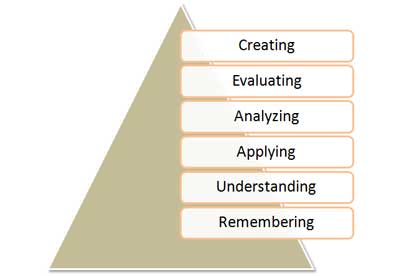
No comments:
Post a Comment